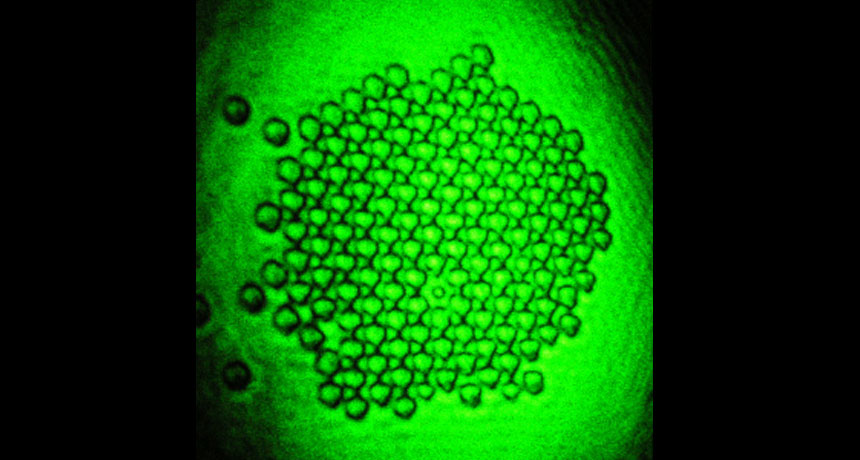Building a mirror with light
A laser pushed floating plastic beads together, creating a reflective surface

A green laser pushed 150 tiny plastic beads together to form a mirror. Physicists want to use the same approach to build giant mirrors in space.
T.M. Grzegorczyk et al./Physics Review Letters 2014
Laser light can’t shove someone around. But a laser’s beam can push plastic beads around a tank full of water. Physicists used a green laser to shove dozens of tiny plastic beads together so that they formed a mini mirror. It wasn’t a great one — its reflection was fuzzy. Still, the experiment proved for the first time that such a feat was possible.
“It’s really cool,” Michael Burns told Science News. A physicist who works with lasers at Harvard’s Rowland Institute in Boston, he didn’t work on the new project. But he does appreciate its laser-built mirror. He says this project “demonstrates something that had only been discussed before.”
And Tomasz Grzegorczyk, who led the new experiment, isn’t content to stop now. He has bigger mirrors in mind — much bigger. This physicist, from BAE Systems in Burlington, Mass., wants to use powerful lasers to build giant mirrors in space. Giant reflecting space telescopes use mirrors to collect light. The curve of these mirrors reflects all that incoming light to a single point, where it forms an image of a distant object in space.
Scientists have proposed that a pair of lasers could be used to assemble tiny particles into a mirror up to 35 meters (114.9 feet) across. Such a reflecting surface would be larger than any telescope mirror — on Earth or in space. And this reflective giant need only weigh as much as a hamburger, scientists have projected.
The idea of a laser-made space mirror makes sense, Burns says. Scientists have long known that when light hits something, it imparts a tiny push. (Of course, only very tiny things, like the beads used in the new experiment, would move in response to such a supersmall shove.)
French astronomer Antoine Labeyrie came up with the idea for such a space mirror in 1979. He envisioned two lasers in space pushing tiny particles together into the gentle curve found in most telescope mirrors.
To investigate how well the idea might work, Grzegorczyk and his coworkers put a few hundred plastic beads into a tank of water. Each microbead was about the size of a bacterium — way too small for people to see. Then they shined a green laser beam into the tank from below. The light shoved about 150 beads to one side of the tank. The scientists projected an image of the number 8 on the assembled beads. The beady mirror reflected that image back and the scientists took a picture to prove it.
They reported their accomplishment January 13 in Physical Review Letters.
There still is a long way to go before scientists can build an actual space mirror. In fact, Burns told Science News, “With current technology, this is still closer to science fiction.”
Yet Grzegorczyk remains optimistic. “If all we have to wait for is the technology, then this will eventually fly.”
Power Words
bacterium (plural bacteria) A single-celled organism forming one of the three domains of life. These dwell nearly everywhere on Earth, from the bottom of the sea to inside animals.
laser A device that generates an intense beam of coherent light of a single color. Lasers are used in drilling and cutting, alignment and guidance, and in surgery.
physics The scientific study of the nature and properties of matter and energy.







